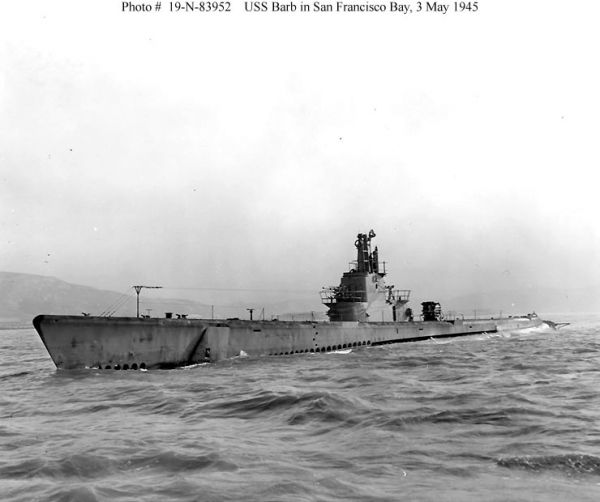The USS
Barb was a
Gato-class
submarine operated by the United States in the Pacific Ocean during
World War II. Under the leadership of Commander Eugene B. Fluckey, who
would be awarded a Medal of Honor and 4 Navy Crosses for his exploits,
the crew of the
Barb devastated Japanese shipping during its patrols. The book
Medal of Honor describes one of those incredible feats:
Early in 1945, the Barb
was moving along the China coast, looking for targets of opportunity.
On January 8, it sank a large Japanese ammunition ship it had been
stalking for hours. Believing a larger group of enemy ships was in the
area, by January 25, Fluckey had located this “mother lode,” as he
called it: a convoy of more than thirty Japanese ships anchored in
Mamkwan Harbor. The harbor was shallow and heavily mined, with
threatening rock formations. It was clear that if the Barb got close to
attack, it would require a nearly impossible run at full speed through
uncharted mine- and rock-obstructed waters to make a successful escape.
Fluckey immediately ordered an attack anyway.
 He managed to
penetrate the perimeter of frigates designed to protect the anchored
ships from submarines. In water of only thirty feet deep, he maneuvered
to within range and launched four torpedoes from the forward tubes, then
fired four more from the rear tubes. After watching eight direct hits
on six main targets—including another ammunition ship whose explosion
damaged craft all around it—he turned the Barb around and
headed for open sea. With Japanese shells hitting all around it, the
Barb had to stay on the surface for almost an hour before reaching
waters deep enough to dive.
He managed to
penetrate the perimeter of frigates designed to protect the anchored
ships from submarines. In water of only thirty feet deep, he maneuvered
to within range and launched four torpedoes from the forward tubes, then
fired four more from the rear tubes. After watching eight direct hits
on six main targets—including another ammunition ship whose explosion
damaged craft all around it—he turned the Barb around and
headed for open sea. With Japanese shells hitting all around it, the
Barb had to stay on the surface for almost an hour before reaching
waters deep enough to dive.
But the crew of the
Barb wasn’t done being spectacular. That summer, the Navy modified the
Barb so that it could launch rockets—the first such American submarine. The
Barb used these to attack an air station and factories in Japan.
Perhaps
their most daring attack at the Japanese Empire came toward the end of
the war when the crew of this submarine attacked a train in Karafuto
Prefecture—what we now call the southern end of the Russian island of
Sakhalin.
On July 23, 1945, the
Barb
approached the coast, sank a frigate, then surfaced about 950 yards
offshore. 8 volunteers paddled ashore in rubber boats and walked 400
yards to a set of railroad tracks. They
rigged explosives to the tracks, then returned to the
Barb. As they paddled back, a 16-car military train passed by, activated the explosives, and blew up.
The
Barb
was mothballed in 1947, reactivated in 1951, then loaned to the Italian
Navy in 1954, before finally being scrapped in 1975. Commander Fluckey
stayed in the Navy after the war, eventually reaching the rank of Rear
Admiral. But by his own account, his greatest accomplishment was keeping
everyone on his ship safe:
No one who ever served under my command was awarded the Purple Heart for being wounded or killed, and all of us brought our Barb back safe and sound.

He managed to penetrate the perimeter of frigates designed to protect the anchored ships from submarines. In water of only thirty feet deep, he maneuvered to within range and launched four torpedoes from the forward tubes, then fired four more from the rear tubes. After watching eight direct hits on six main targets—including another ammunition ship whose explosion damaged craft all around it—he turned the Barb around and headed for open sea. With Japanese shells hitting all around it, the Barb had to stay on the surface for almost an hour before reaching waters deep enough to dive.

No comments:
Post a Comment